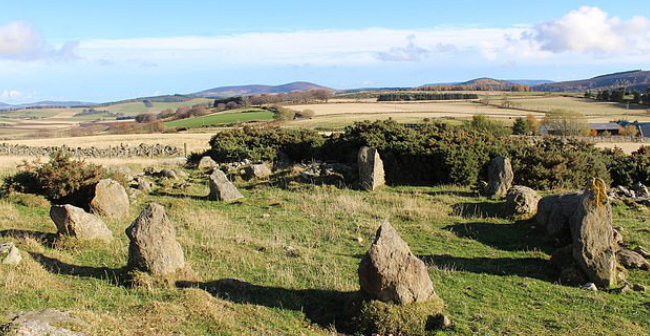
Archaeologists have “discovered” a Stonehenge-like circle in rural Scotland, only to find that farmers and locals have known about it for generations. The complete stone circle is near Alford, and was reported by Fiona Bain whose family has farmed the land for years. It is thought that the circle was constructed around 3,500-4,500 years ago and each stone stands about three feet high.
Adam Welfare from Historic Environment Scotland explained how the monument in Leochel-Cushnie was different from other examples found. He said, “Its diameter is about three metres smaller than any known so far and it is unusual in that all the stones are small.”
Although news to archaeologists, locals have been walking their dogs past the monument for years. One member of a Scottish farming family, now in her 80s, said she remembered seeing the stone circle at some time in the 1930s. However the circle was on farmland and far from main roads, meaning it wasn’t easy to notice.
Mr Ackerman added that the stone circle near Alford may be one of the last complete examples that will be found in the northeast area of Scotland. He said, “There are a few parts of Aberdeenshire and the northeast of Scotland in general that aren’t as well-surveyed as other areas —and this is one of the areas that had less work done on it in the past.”
This newly-recognised stone circle will add to the understanding of this period of the prehistory of northeast Scotland and of these sites. Chair of the Marr Area Committee, Moira Ingleby, said, “Adding it to the record of known sites will add to the understanding of these fantastic monuments that are unique to the area.”
本时文内容由奇速英语国际教育研究院原创编写,未经书面授权,禁止复制和任何商业用途,版权所有,侵权必究!(作者投稿及时文阅读定制请联系微信:400-1000-028)
1.Which of the following about the Stonehenge-like circle is TRUE?
A The Stonehenge-like circle was found in urban Scotland.
B No one except the archaeologists has known the stone circle ever before.
C It’s Fiona Bain’s family who reported the discovery of the stone circle.
D Each stone in the stone circle stands about three feet high.
解析:选D。细节理解题。根据第一段最后一句It is thought that the circle was constructed around 3,500-4,500 years ago and each stone stands about three feet high. 可知,小巨石阵的每块石头大约有3英尺高。故选D。
2.What makes the stone circle different from other examples?
A The time.
B The material.
C The size.
D The color.
解析:选C。推理判断题。根据第二段最后一句Its diameter is about three metres smaller than any known so far and it is unusual in that all the stones are small.可知该石阵的石头都很小,这让它与其他已知石阵有所不同,因此让该石阵与众不同的是其尺寸。故选C。
3.What can’t we get from the passage?
A The locals are familiar with the stone circle.
B The stone circle are far from the main roads.
C The stone circle is one of the last complete examples.
D The whole northeastern part of Scotland has already been well-surveyed.
解析:选D。细节理解题。根据第四段最后一句的There are a few parts of Aberdeenshire and the northeast of Scotland in general that aren’t as well-surveyed as other areas可知苏格兰东北部的一些地区未被好好勘察过,并非全都勘察过了。故选D。
4.What’s the meaning of this new discovery according to the last paragraph?
A It will help people understand northeast Scotland’s history and geography.
B It will be able to make northeast Scotland much more fantastic.
C It will add much attraction to the record of those known sites.
D It will let more and more fantastic monuments be found.
解析:选A。细节理解题。根据最后一段第一句This newly-recognised stone circle will add to the understanding of this period of the prehistory of northeast Scotland and of these sites.可知此次发现将有助于人们更好地了解这个地区的历史和地理。故选A。